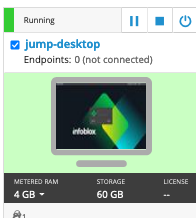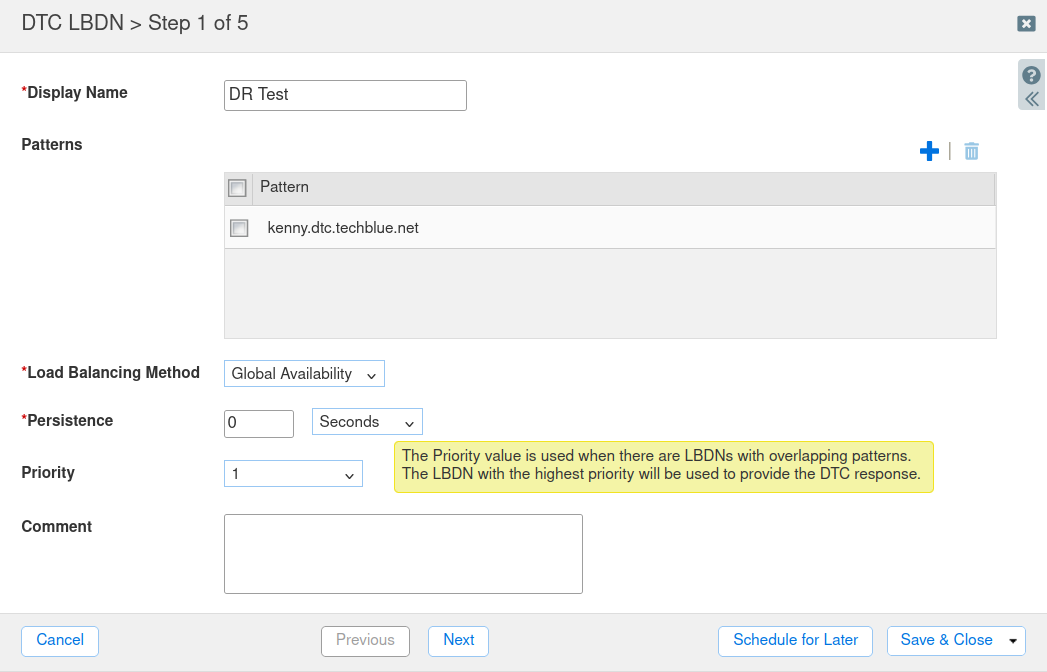Testing Disaster Recovery Topology for DNS Traffic Control (2584)
This lab requires a NIOS 9.0 Lab Environment
This lab guide has been developed using the new NIOS 9.0 Lab Environment. Please ensure that you deploy a NIOS 9.0 lab environment to complete these lab tasks. If you use a different lab environment, this is untested, and the lab likely will not work.
Scenario
Your organization is setting up a disaster recovery configuration using DNS Traffic Control (DTC) to improve resilience and maintain access to services during outages. The goal is to ensure that, if primary servers go offline, users are automatically redirected to backup servers in a secondary data center.
Estimate Completion Time
15 to 25 minutes
Credentials
Description | Username | Password | URL or IP |
|---|---|---|---|
Grid Manager UI | admin | infoblox |
Requirements
Administrative access to the Grid
Lab Initiation
Access jump-desktop
Once the lab is deployed, you can access the virtual machines required to complete this lab activity. To initiate the lab, click on the jump-desktop tile and login to the Linux UI:

Username: training
Password: infoblox
Initiate lab
To initiate the lab, double-click the Launch Lab icon on the Desktop.

Launch Lab
Choose the lab number from the list and click OK.

After clicking OK, you will see a pop-up message with a brief description of the lab task. If the description looks correct, click Yes to continue lab initiation.

Lab initiation will take a couple of minutes to finish.
Once complete, you will see another pop-up message with the login credentials and the URL for the Grid Manager’s User Interface. Note that the credentials may differ from those from prior labs.

Tasks
Task 1: Set Up the Load-Balanced Domain Name (LBDN)
Create an LBDN for the pattern kenny.dtc.techblue.net configured with Global Availability as the load balancing method.
Task 2: Test the LBDN (Normal Conditions)
Use the Test LBDN tool to verify that the LBDN for kenny.dtc.techblue.net is functioning as expected.
For the test, use the following details:
Query Source:
[Use any IP address]Query Name:
kenny.dtc.techblue.netMember:
ibns1.techblue.netRecord Type: A
Task 3: Simulate a Disaster Event
Disable the IPs in Pool A to test disaster recovery to simulate an outage. Log in to the Support-server VM, open a Terminal, and execute the dtc-remove-primary command. This will make Pool A servers (srvr1.dtc.techblue.net at 10.100.0.210 and srvr2.dtc.techblue.net at 10.100.0.220) unavailable, allowing you to verify that traffic is redirected to Pool B in Task 4.
Task 4: Test the LBDN (After Disaster)
Verify that the LBDN redirects traffic to Pool B after the simulated outage using the Test LBND Tool.
Solutions
Task 1 Solution: Set Up the Load-Balanced Domain Name (LBDN)
Set up the LBDN by following these steps:
Navigate to Data Management → DNS → Traffic Control.
Click the Add dropdown menu and select LBDN to open the DTC LBDN Wizard.
In Step 1 of the wizard, enter the following details:
Display Name:
DR TestPatterns: Click + to add a new pattern, then enter
kenny.dtc.techblue.net.Load Balancing Method: Global Availability

Click Next to proceed.
In Step 2, verify that the following record types are selected:
A
CNAME
AAAA
Click Add (+) and select the Associated Zone dtc.techblue.net, then click Next.
In Step 3, click Add (+) to add Pool A and Pool B.
Click Save & Close to complete the LBDN setup.
When prompted, select Restart Services to apply the changes.
Task 2 Solution: Test the LBDN (Normal Conditions)
To test the configuration under normal conditions, follow these steps:
Navigate to Data Management → DNS → Traffic Control.
Select the LBDN DR Test.
From the Toolbar, click Test LBDN to open the Test DTC LBDN (Web) tool.
Enter the following test details:
Query Source:
[Use any IP address]Query Name:
kenny.dtc.techblue.netMember:
ibns1.techblue.netRecord Type: A
Click Start to initiate the test. Run the query a few times and observe the responses, which should be directed to Pool A (10.100.0.210 or 10.100.0.220).
Task 3 Solution: Simulate a Disaster Event
To simulate an outage for disaster recovery, follow these steps:
Login to the VM Support-server with the following credentials:
Username: training
Password: infoblox
Launch the Terminal on the Support-server.
Execute the command:
dtc-remove-primary. This command disables the IPv4 addresses for the server objects in Pool A (10.100.0.210 and 10.100.0.220).
Task 4 Solution: Test the LBDN (After Disaster)
After simulating the disaster event, verify that traffic is redirected to Pool B:
Navigate to Data Management → DNS → Traffic Control.
Select the LBDN EA Test.
From the Toolbar, click Test LBDN to open the Test DTC LBDN (Web) tool.
Enter the following test details:
Query Source:
[Use any IP address]Query Name:
kenny.dtc.techblue.netMember:
ibns1.techblue.netRecord Type: A
Click Start to initiate the test. Run the query a few times and observe the responses, which should be directed to Pool B (10.200.0.210 or 10.200.0.220).
Note: To recover the primary data center server IPs, you may run the dtc-add command from support-server VM, which will re-enable srvr1.dtc.techblue.net and srvr2.dtc.techblue.net.
